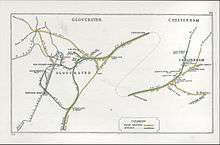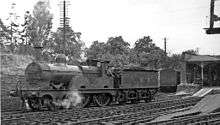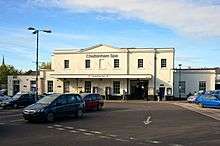Cheltenham Spa railway station
Cheltenham Spa railway station is a railway station serving Cheltenham in Gloucestershire, England. Situated on the Bristol-Birmingham main line, it is managed by Great Western Railway (despite most services being operated by CrossCountry, which does not manage any stations) and is about one mile from the town centre. The official name of the town is simply Cheltenham, but, when the station was renamed in 1925, the London, Midland and Scottish Railway chose to add Spa to the station name.[1]
| Cheltenham Spa | |
|---|---|
.jpg) Platforms at Cheltenham Spa station (2018) | |
| Location | |
| Place | Cheltenham |
| Local authority | Cheltenham |
| Coordinates | 51.897°N 2.100°W |
| Grid reference | SO931220 |
| Operations | |
| Station code | CNM |
| Managed by | Great Western Railway |
| Number of platforms | 2 |
| DfT category | C1 |
| Live arrivals/departures, station information and onward connections from National Rail Enquiries | |
| Annual rail passenger usage* | |
| 2014/15 | |
| – Interchange | |
| 2015/16 | |
| – Interchange | |
| 2016/17 | |
| – Interchange | |
| 2017/18 | |
| – Interchange | |
| 2018/19 | |
| – Interchange | |
| History | |
| Original company | Birmingham and Gloucester Railway |
| Pre-grouping | Midland Railway |
| Post-grouping | LMS |
| 24 June 1840 | Opened as Cheltenham |
| 1 February 1925 | Renamed Cheltenham Spa (Lansdown) |
| ? | Renamed Cheltenham Spa |
| National Rail – UK railway stations | |
| * Annual estimated passenger usage based on sales of tickets in stated financial year(s) which end or originate at Cheltenham Spa from Office of Rail and Road statistics. Methodology may vary year on year. | |
History


The first railway to Cheltenham was the broad-gauge Cheltenham and Great Western Union Railway (C&GWUR), authorised by Act of Parliament in 1836, and opened between Cheltenham and Gloucester in 1840. In the same year, the Birmingham and Gloucester Railway (B&GR) opened its line between Cheltenham and Bromsgrove, whence trains ran on mixed-gauge tracks to Gloucester. Both railways had their own stations, but the B&GR station, which was then on the edge of the town and was named Lansdown after a housing development in that area,[2] is the only one remaining. The buildings were designed by the architect Samuel Daukes. Opened by the B&GR on 24 June 1840 as Lansdown,[1] it was renamed Cheltenham Spa (Lansdown) on 1 February 1925 by the London, Midland and Scottish Railway, and renamed again as Cheltenham Spa by British Railways at some point after 1 January 1948.[3]
The C&GWUR was taken over by the Great Western Railway in 1844, and the B&GR by the Midland Railway in 1846. Within the town, there were three other passenger railway stations: Malvern Road, St James's and Cheltenham South and Leckhampton; there was also High Street Halt and the Racecourse Platform, open only on race days.
Cheltenham Spa Malvern Road West Signal Box, and its east equivalent, had the longest namesigns on the GWR.
Services

| Railways around Cheltenham | ||||||||||||||||||||||||||||||||||||||||||||||||||||||||||||||||||
|---|---|---|---|---|---|---|---|---|---|---|---|---|---|---|---|---|---|---|---|---|---|---|---|---|---|---|---|---|---|---|---|---|---|---|---|---|---|---|---|---|---|---|---|---|---|---|---|---|---|---|---|---|---|---|---|---|---|---|---|---|---|---|---|---|---|---|
| ||||||||||||||||||||||||||||||||||||||||||||||||||||||||||||||||||
Cheltenham Spa station is served by approx 8 to 12 trains every hour during the daytime on Mondays to Saturdays (less frequent on Sundays).
Great Western Railway operate approx hourly Cheltenham Spa – Swindon via Gloucester services. Some (operated by Class 800s) extend through to Didcot Parkway, Reading and London Paddington.[4]
Great Western Railway also operates local services on the Bristol (Temple Meads/Parkway) to Gloucester, Cheltenham Spa and Worcester Shrub Hill route.[5] These serve Cheltenham every two hours each way, with some southbound services continuing onwards to Westbury, Weymouth or Brighton.
CrossCountry trains serve Cheltenham Spa on three routes, the Cardiff Central to Birmingham New Street/Nottingham service, the longer-distance Penzance/Plymouth – Cheltenham Spa – Glasgow Central, with extensions to Aberdeen, and the Bristol Temple Meads – Manchester Piccadilly routes.[6] All three of these services run hourly each way, giving a net half-hourly service to Bristol Temple Meads and three departures per hour to/from Birmingham New Street. CrossCountry also operate a morning service to Stansted Airport as well as summer Saturday trains to Newquay.
Transport for Wales operate approximately hourly with a Maesteg via Bridgend, Cardiff Central, Newport and Chepstow to Gloucester and Cheltenham Spa service.[7]
West Midlands Trains used to operate a once a week limited service from Birmingham New Street to Gloucester on Friday evenings but this ended in May 2019.
| Preceding station | Following station | |||
|---|---|---|---|---|
| Gloucester | Transport for Wales Maesteg – Cheltenham |
Terminus | ||
| Gloucester | CrossCountry Cardiff – Nottingham |
Worcestershire Parkway or Ashchurch for Tewkesbury | ||
| Bristol Parkway | CrossCountry South West – North East and Scotland |
Birmingham New Street | ||
| CrossCountry Bristol – Manchester |
||||
| Gloucester | Great Western Railway Cheltenham – London/Swindon |
Terminus | ||
| Gloucester | Great Western Railway Great Malvern – Westbury |
Ashchurch for Tewkesbury | ||
| Historical railways | ||||
| Churchdown Line open, station closed |
Midland Railway Birmingham and Gloucester Railway |
Cheltenham High Street Line open, station closed | ||
| Disused railways | ||||
| Terminus | Great Western Railway Midland and South Western Junction Railway |
Leckhampton Line and station closed | ||
| Cheltenham Malvern Road Line and station closed |
Gloucestershire Warwickshire Railway | Terminus | ||
Redevelopment proposals
In early 2012 Cheltenham Council released a Railway Station concept statement, promoting various enhancements at the station.[8] This was followed in March 2013 by the newly formed Gloucestershire Local Transport Body (LTB) asking for bids from the local area for transport projects which could be funded in the period 2015 to 2019. The Cheltenham Development Taskforce decided to seek support from the railway industry and key local supporters, to promote a scheme first raised in 2008. This proposed to significantly enhance the station, with new passenger facilities and a new south-facing bay platform to enable terminating London and South Wales services to turn back in the station clear of the mainline rather than having to run empty to the carriage sidings north of the station at Alstone to reverse as at present.
During the development and optioneering phase of the stage 1 LTB submission, it was discovered that to ensure operational flexibility and to provide sufficient capacity, that two new bay platforms were actually required. This configuration formed the basis of a station regeneration proposal that was submitted to the Gloucestershire Local Transport Body for consideration in early March 2013. Following short listing to stage 2, a second funding proposal was submitted on 10 May 2013. Cheltenham Spa Station and the other various transport scheme proposals were all published for public consultation on the LTB website on 13 May 2013.[9]
However, in February 2014 the scheme was shelved after both Network Rail and train operator First Great Western refused to back the portion of the proposals relating to the additional platforms, though they were supportive of the need to upgrade other passenger facilities (station building & taxi/bus interchange improvements and better car parking).[10]
References
- "Cheltonia: The curiosities of Cheltenham Spa, past and present". Retrieved 14 August 2016.
- "Cheltonia: The curiosities of Cheltenham Spa, past and present". Retrieved 14 August 2016.
- Butt, R.V.J. (1995). The Directory of Railway Stations. Yeovil: Patrick Stephens Ltd. p. 59. ISBN 1-85260-508-1. R508.CS1 maint: ref=harv (link)
- GB National Rail Timetable 2014–15, Table 125
- GB National Rail Timetable 2014–15, Tables 57, 123 & 134
- GB National Rail Timetable 2014–15, Tables 51 & 57
- GB Rail Timetable 2014–15, Tables 128 & 134
- Cheltenham Spa railway station concept statementCheltenham Borough Council website; Retrieved 21 March 2015
- http://www.gloucestershire.gov.uk/CHttpHandler.ashx?id=55015 Archived 2 April 2015 at the Wayback Machine "Cheltenham Spa Station – A Transformational Ambition" Gloucestershire LTB; Retrieved 21 March 2015
- Plans for two new platforms at Cheltenham Spa railway station controversially shelved Archived 2 April 2015 at the Wayback Machine Maidment, J.R ; Gloucestershire Echo 4 February 2014; Retrieved 21 March 2015,
Further reading
| Wikimedia Commons has media related to Cheltenham Spa railway station. |